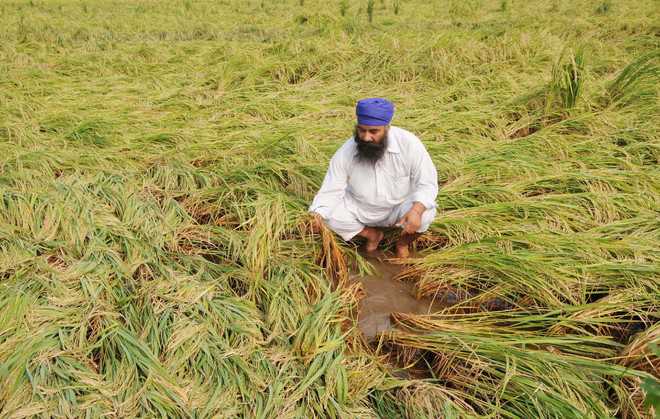
The types of damage that crops suffer vary widely in different parts of the country. The insurance policies need to take that into consideration. Tribune file photo
Amarjit Thind
Tribune News Service
Chandigarh, August 6
Crop loss for any reason is a setback farmers of Punjab – most of whom are small – can hardly sustain. Yet, there are no takers in the state for the crop insurance scheme offered by the Central Government. The state has some very valid reasons for that, all simple economics. At a larger level, it is the ‘one size fits all’ approach of successive governments that may be to blame.
As the arrangements stand today, what a farmer in Punjab gets is “compensation” for the damage. But this mostly remains meaningless, as often the relief is Rs 5,000, or even smaller amounts, paid by the state government for losses of up to Rs 40,000-50,000 per acre.
The Pradhan Mantri Fasal Bima Yojana (PMFBY) was touted as a radical solution for its beneficiaries by Prime Minister Narendra Modi. Ground realities, however, reveal that it has turned out to be another money-spinner dished out by insurance companies, facilitated by the government. Farmers of Punjab say they had no say in the formulation of the policy so crucial to them.
THE PUNJAB EXPERIENCE
Thus far, Punjab, Sikkim, Manipur and Nagaland have not implemented the PMFBY, while it is operational or will be soon in Gujarat, Uttar Pradesh, Chhattisgarh, Andhra Pradesh, West Bengal, Maharashtra, Odisha, Jharkhand, Tamil Nadu, Himachal Pradesh, Uttarakhand and Assam.
Old-timers like Bishan Singh and Bachan Singh of Khaira Dona village in Kapurthala district recall that farmers have been the losers in all farm insurance schemes implemented by the Centre since the Individual Approach Basis Scheme was launched in 1972. They have memories of the ‘great flood’ of 1962 and the pittance received as compensation. A few rupees, some blankets, but no “insurance”. Officially, nearly 20 per cent of the cropped area was damaged in floods that year as compared to 13 per cent and 10 per cent in 2009 (15 dead) and 1988 (200 dead), respectively.
In well-irrigated Punjab, those were the heady days of the Green Revolution (paddy was recording an increase of 5.30 per cent per annum), whereas most of the insurance schemes were tailor-made for rain-fed agriculture of many other states.
The Comprehensive Crop Insurance Scheme (CCIS- 1985) focused largely on drought, whereas the state’s farmers wanted only insurance for hailstorm but with higher indemnity. Successive governments – both the SAD and the Congress – over the decades only paid lip service on this count. Policies were framed, scrapped and re-framed, but turned out to be just old wine in fancy new bottles each time, says BS Rajewal of the BKU.
WHY PMFBY DOESN’T WORK
In its present avatar, the major flaw in the farm insurance scheme is that it comes into play only if there is 40 per cent crop damage in a village, which is counted as a single unit for availing any relief, says Rajewal.
First, farmers want that instead of being village-specific, the scheme should be farm plot-specific, with crop indemnity (compensation) levels above 95 per cent.
Secondly, farmers demand that the 10-year benchmark for assessing ‘normal’ yield levels while deciding on the insurance premium should be scrapped, and the latest yield should be taken into account.
The premium should also be standardised to 1 per cent for all crops, as crop losses in Punjab are very low as compared to the rest of the country.
Thirdly, the crop lying in market yards should also be covered. At present, only the harvested crop in the fields lies within the ambit of the scheme. Largely mechanised harvesting operations and relatively easy access to markets in Punjab ensure that the crop reaches mandis within hours. Hence, it needs protection from the vagaries of weather in the mandi, where it may await procurement for days.
In view of stiff opposition by the peasantry and farmer unions, the scheme has been given a quiet burial by the state government.
In a meeting on this issue with senior officials of the Union Agriculture Ministry and the insurance companies a couple of years ago, Rajewal says he asked if the rationale of the entire village being a single unit was applied to vehicles or life insurance. Would the company only settle claims if 40 people died or 40 vehicles were involved in a pile-up? Needless to say, that was the end of it, he added.
Haryana implemented the scheme and its farmers have alleged that the insurance companies collected over Rs 750 crore in premium, but only disbursed Rs 112 crore as compensation. The matter was even raised in Parliament, Rajewal claims.
KEEP ARHTIYA OUT
Buta Singh Burj Gill, president of the BKU (Dakaunda), too minces no words in denouncing the scheme in its present form as anti-farmer and pro-corporate. We desperately need insurance but not at these costs and terms, he added.
There are no takers for even premiums heavily subsidised by the Centre and the states (in equal proportion). Farmers pay 2 per cent of the premium for kharif crops, 1.5 per cent for rabi and 5 per cent for horticulture crops. On an average, a farmer has to pay Rs 800 per acre for rabi and kharif crops and Rs 1,250 per acre for cotton as premium. They are not able to bear that cost.
The need is to scrap the arhtiya system. The money/profits collected by this system under the present procurement arrangement can be used to pay the PMFBY premium, saving both farmers and the government this recurring fiscal burden once and for all, Gill suggests.
The Mandi Board is equipped to buy the produce from the farmers, and everyone would be more than willing to clean the crop, weigh it and transport it to the nearest state godown. This would not only provide employment to the landless labourers, but also mean an additional income for the farmers on freight charges, he pointed out. As it is, farmers transport the produce to the mandis.
When the government knows that the farmers are fiscally distressed and committing suicides, why burden them with another life-long liability, asks Gill.
UNRESPONSIVE STATE GOVTS
Punjab’s reluctance to implement the PMFBY also drew the attention of Union Agriculture Minister Radha Mohan Singh, who told the Rajya Sabha recently that the state should seriously consider implementing the scheme as it had neither sent a draft for drought relief nor done crop insurance in the past five years.
“I have seen the record of the state; Punjab’s farmers do not go in for crop insurance. But during drought, even a request for relief was not made to us,” he added.
Under the PMFBY, there would be no upper limit on the subsidy provided by the Centre or the state. “Even if the balance premium (after farmers’ contribution) is 90 per cent, it will be borne by the government,” according to an official.
In previous schemes, the premium had been capped, which resulted in low claims being paid to farmers. This was done to limit the government outgo on the premium subsidy. “This has been removed. Farmers will get the claim against the full sum insured without any deductions,” the official says.
Another benefit of the PMFBY is that losses incurred from the sowing stage to the post-harvest season would all be covered. Earlier, only post-harvest losses could be offset. Farmers who haven’t availed bank loans would also be eligible for insurance cover.
Solution in guaranteed income; production, market risk both coverED
While farmer unions have been agitating for implementing the MS Swaminathan Commission recommendations and bureaucrats are clueless on what to do, a report by Punjab Agricultural University (PAU), Ludhiana, in 2014 suggested that a study of all insurance schemes since 1974 till date had revealed that opting for the Farm Income Insurance Scheme (FIIS-2003-04) would be the best bet for Punjab.
As this is the sole scheme covering both production and market risk, it could also be used for giving a boost to the flagging diversification drive of the state, the PAU study observed.
It envisages targeting two critical components that decides a farmer’s income — yield and price — through a single policy instrument by ensuring a “minimum guaranteed income” determined by using the average yield for the previous seven years and the MSP. If the actual income falls short of the guaranteed sum, the farmer would be eligible for compensation to the extent of indemnity from the Agricultural Insurance Company (AIC) of India.



























